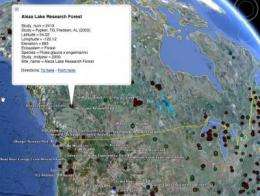Even soil feels the heat: Soils release more carbon dioxide as globe warms

Twenty years of field studies reveal that as the Earth has gotten warmer, plants and microbes in the soil have given off more carbon dioxide. So-called soil respiration has increased about one-tenth of 1 percent per year since 1989, according to an analysis of past studies in today's issue of Nature.
The scientists also calculated the total amount of carbon dioxide flowing from soils, which is about 10-15 percent higher than previous measurements. That number -- about 98 petagrams of carbon a year (or 98 billion metric tons) -- will help scientists build a better overall model of how carbon in its many forms cycles throughout the Earth. Understanding soil respiration is central to understanding how the global carbon cycle affects climate.
"There's a big pulse of carbon dioxide coming off of the surface of the soil everywhere in the world," said ecologist Ben Bond-Lamberty of the Department of Energy's Pacific Northwest National Laboratory. "We weren't sure if we'd be able to measure it going into this analysis, but we did find a response to temperature."
The increase in carbon dioxide given off by soils -- about 0.1 petagram (100 million metric tons) per year since 1989 -- won't contribute to the greenhouse effect unless it comes from carbon that had been locked away out of the system for a long time, such as in Arctic tundra. This analysis could not distinguish whether the carbon was coming from old stores or from vegetation growing faster due to a warmer climate. But other lines of evidence suggest warming is unlocking old carbon, said Bond-Lamberty, so it will be important to determine the sources of extra carbon.
The Opposite of Photosynthesis
Plants are famous for photosynthesis, the process that stores energy in sugars built from carbon dioxide and water. Photosynthesis produces the oxygen we breathe as a byproduct. But plants also use oxygen and release carbon dioxide in the same manner that people and animals do. Soil respiration includes carbon dioxide from both plants and soil microbes, and is a major component of the global carbon cycle.
Theoretically, the biochemical reactions that plants and soil microbes engage in to produce carbon dioxide suggest that higher temperatures should result in more carbon dioxide being released. But unlike the amount of sunlight reaching Earth, soil respiration can't be measured from space and can't yet be simulated effectively with computer models.
So, the researchers turned to previous studies to see if they could quantify changes in global soil respiration. PNNL's Bond-Lamberty and his colleague Allison Thomson, working at the Joint Global Change Research Institute in College Park, Md., examined 439 soil respiration studies published between 1989 and 2008.
They compiled data about how much carbon dioxide has leaked from plants and microbes in soil in an openly available database. To maintain consistency, they selected only data that scientists collected via the now-standard methods of gas chromatography and infrared gas analysis. The duo compared 1,434 soil carbon data points from the studies with temperature and precipitation data in the geographic regions from other climate research databases.
After subjecting their comparisons to statistical analysis, the researchers found that the total amount of carbon dioxide being emitted from soil in 2008 was more than in 1989. In addition, the rise in global temperatures correlated with the rise in global carbon flux. However, they did not find a similar relation between precipitation and carbon.
Zooming In
Previous climate change research shows that Arctic zones have a lot more carbon locked away than other regions. Using the complete set of data collected from the studies, the team estimated that the carbon released in northern -- also called boreal -- and Arctic regions rose by about 7 percent; in temperate regions by about 2 percent; and in tropical regions by about 3 percent, showing a trend consistent with other work.
The researchers wanted to know if their data could provide more detailed information about each region. So they broke down the complete data set by regional climates and re-examined the smaller groups of data using different statistical methods. The regional data from the temperate and tropical climates produced results consistent with other results, such as more carbon being released at higher temperatures, but the boreal-Arctic climate data did not. In addition, removing only 10 percent of the boreal-Arctic data points was enough to invalidate the statistical significance of the boreal-Arctic result. Together, the results support the idea that more boreal data on regional climates is needed to reach statistical relevance.
"We identified an area where we need to do more work," said Thomson.
More information: Bond-Lamberty and Thomson, 2010. Temperature-associated increases in the global soil respiration record, Nature March 25, 2009, doi:10.1038/nature08930
Provided by Pacific Northwest National Laboratory















